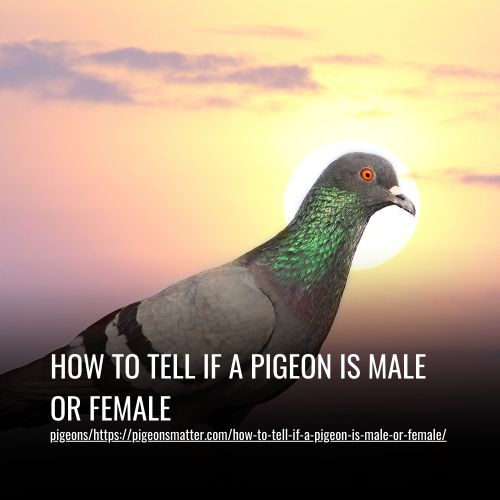Determining the sex of a Pigeon visually can be challenging, as males and females look remarkably similar. However, few physical features can help you identify whether the bird is male or female. Typically, males tend to have a more upright posture than females, and juvenile males are more upright than adult males. Another noticeable feature is the shape of their head – females have a smoother, round head, while males have a sharper, more rounded one.
While both sexes possess a white throat patch and a violet breast, female pigeons have slightly smaller patches and paler breasts compared to their male counterparts. Dominant males are likely to have more considerable white throat patches and brighter violet breasts than other males. Besides those differences, there are no other visual cues that can identify the sex of the pigeon.
It’s worth noting that identifying the sex of the pigeon by visual means alone is not a reliable method. Experienced pigeon breeders can tell the difference between male and female birds by subtle variations in behavior and other characteristics such as eye color, neck thickness, and the shape of their anal vents. Alternatively, some bird enthusiasts rely on scientific methods like DNA testing or sifting through the blood sample.

What Does A Female Pigeon Look Like?
Female pigeons possess many physical traits that are very similar to their male counterparts. They have subdued plumage with a violet-purple breast, yellow eyes, an orange bill, and a white wing bar. It’s worth noting that some females may also have a turquoise-green patch above the white throat patch and a slight iridescence to the lower neck.
However, there are a few physical differences that can help differentiate females from males. Females tend to have a slightly smaller beak and a slightly shorter tail than males. Also, males are generally larger with significant white throat patches and a more upright posture. Overall, these physical differences can be subtle, and identifying female pigeons by looks alone can be challenging.
Are Female Pigeons Bigger Than Males?
During the breeding season, it can be challenging to differentiate between male and female pigeons based on physical differences. However, if we look closely, we will see that males are slightly larger than females, and they have more extensive white throat patches and an upright posture.
Despite this, female pigeons are pretty much the same size as males, and both sexes are visually alike, making it challenging to determine their gender without careful observation.
Different Ways For Determining Pigeon Gender
One way to determine pigeon’s gender is to observe their physical traits. Male pigeons are generally larger and have a more robust chest. They also have a characteristic “double crest” of feathers on their head, while females have a single crest. Additionally, males have larger combs and wattles than females.
Another method to determine gender is by checking their reproductive organs. Males have two protruding cloacas, while females have a single, round cloaca located at the tip of the tail. Pigeons can also be sexed using DNA testing or physical measurement techniques like Pendulum Sexing.
When it comes to behavior, male pigeons are known for their aggressiveness and territoriality, while females are more likely to share a territory. Males can also be more promiscuous, while females are more inclined to stay monogamous.
Apart from subtle physical differences, the building of their nests can also provide a clue to pigeon gender. Males typically use larger and sturdier materials like sticks and metal wiring, while females use softer materials like grasses and feathers to fashion their nests.
Different Ways For Determining Pigeon Gender
When it comes to determining pigeon gender, understanding their reproductive strategies can be a useful starting point. Female pigeons place more investment in reproduction, producing one offspring and dedicating themselves to its care, while males produce many offspring but do not invest as much in their care. Additionally, females select their mates while males compete for mates, leading to differences in behavior between the sexes.
One of the most noticeable physical differences between male and female pigeons is in their head and neck. Males have a thicker neck with a more pronounced bulge at the top of their heads, while females have a thinner neck and less of a bulge. This is because male pigeons use their necks to fight and display aggressive behavior, while females do not.
The eyes of male and female pigeons also provide clues to their gender. The iris of a male pigeon’s eye is often a darker color than a female’s, and the pupil of a male’s eye is usually more elongated compared to a female’s. Around the eyes, the area surrounding a male pigeon’s eye is usually more feathered than that of a female pigeon’s eye.
While the bone structure of male and female pigeons is generally the same, there are some exceptions. For example, the elongated pelvic bones of male pigeons better support their reproductive organs compared to the shorter pelvic bones of female pigeons.
Using these key differences in behavior and physical traits, one can determine pigeon gender with accuracy. These common methods provide reliable ways to distinguish male from female pigeons and are essential knowledge for any bird enthusiast or experienced pigeon breeder.
Different Ways For Determining Pigeon Gender
Physical differences, body size, tail feathers, cloacal vents, and aggression are key indicators to determine the gender of a pigeon. Toes are another distinguishing feature, as male pigeons have one spur on their feet, while females have two. During courtship, males will often present their spurs to females in hopes of gaining acceptance. If the female touches her beak to the male’s spur, it’s a sign that she accepts him.
Mating behavior in pigeons can be divided into two stages: the male pursuit stage and the female choice stage. During the pursuit stage, male pigeons exhibit behaviors such as tail-wagging and cooing to attract a female. The female then enters into a courtship ritual with the male to determine if she will accept or reject him.
During copulation, male pigeons stand on top of females and flap their wings rapidly to spread their scent and show interest. If the female is receptive, they will mate.
Incubation can also provide clues about the gender of pigeons. Higher incubation temperatures tend to result in more female chicks, while lower temperatures lead to male chicks.
Different Ways For Determining Pigeon Gender
There are several methods to identify the gender of a pigeon. Physical differences like tail feathers, cloacal vents, and toes are important indicators. Another physical attribute that can help with pigeon gender identification is examining the distance between the eyes and beak. If this distance is more than the width of an eye, then it’s likely a female pigeon.
Pigeon aggression and behavior can also help to determine gender. The aggression test involves observing the intensity of response when a pigeon is confronted by another bird. Generally, males tend to be more aggressive in their approach than females. They exhibit a wide range of behaviors such as pecking, bowing, and lunging. In contrast, females are typically less aggressive and may only attack if they sense a threat or their chicks are in danger.
Performing a ‘Wing Test’ can also help to differentiate male and female pigeons. While male and female pigeons may look similar, examining the tips of their wings can give a clue about the pigeon’s gender. If the tips of the wings curve inward, then the pigeon is male. In contrast, if the tips of the wings curve outward, then it’s a female pigeon.
Pendulum sexing is another method used to determine the sex of pigeons. This method involves examining the shape of the pelvic bones. Male pigeons have more U-shaped pelvic bones, while female pigeons have more V-shaped ones. Although not 100% accurate, pendulum sexing provides a good indication of a pigeon’s sex.
What are the male and female pigeon’s differences?
When it comes to telling the difference between male and female pigeons, there are a few key physical characteristics to look out for. Male pigeons typically have a more rounded head, and thicker neck, and are generally heavier than their female counterparts. These subtle differences are the easiest way to identify whether a pigeon is male or female.
How can you tell a female pigeon from a male pigeon?
To distinguish between male and female pigeons, start by examining their size. Female pigeons are typically smaller in size compared to males.
FAQs
To distinguish male pigeons from female pigeons, observe their posture. Male pigeons typically have a more upright posture compared to females. In addition, male pigeons are larger, have a rounder head, and thicker neck, and are generally heavier than females.
Figuring out whether a pigeon is male or female might seem daunting, especially for beginners. However, certain physical characteristics can help determine the gender. Firstly, consider the size of the bird. Males are typically larger compared to females with a more rounded head, a thicker neck, and an overall heavier body weight. Additionally, females often coo more and may display aggressive behavior.
Male pigeons are more vocal and can display aggressive behavior, while female pigeons are generally calmer and less aggressive. During mating, male pigeons take the dominant position and incubate the eggs in the morning.
To identify a male pigeon, you can look for a rounded head, a thicker neck, and a heavier appearance. They vocalize more frequently and are more prone to aggressive behavior. During mating, males take the dominant position and incubate eggs in the morning.
Differentiating a female pigeon from a male can be done by observing slight differences in their physical characteristics. Female pigeons have a smaller size, a less prominent white throat patch, and a less vibrant breast color. Sometimes, females also have a more smoothly rounded head compared to their male counterparts.
When it comes to determining pigeon gender, DNA testing is the only method that can provide a 100 percent accurate result. The other methods mentioned above may not provide a reliable outcome. If you want to be certain about the gender of your pigeon, DNA testing is the way to go.
Wood pigeons have a strong pair bond that has helped them become one of the most common pigeons in Europe. Nest building, incubation, and rearing chicks are tasks that both the male and female participate in. It’s unclear if a female wood pigeon could handle all these responsibilities alone, but it would likely be a difficult task for her.
Conclusion:
Being able to distinguish between male and female pigeons is important for bird enthusiasts and experienced pigeon breeders alike. While DNA testing and physical measurement are the most reliable methods, there are also behavioral and physical differences to look out for.
By paying attention to subtle differences such as tail feathers, neck feathers, and body mass, it is possible to accurately determine the sex of a pigeon without the need for expensive DNA testing. This article provides a comprehensive overview of the key differences between male and female pigeons, allowing readers to confidently identify the sex of these fascinating birds.


